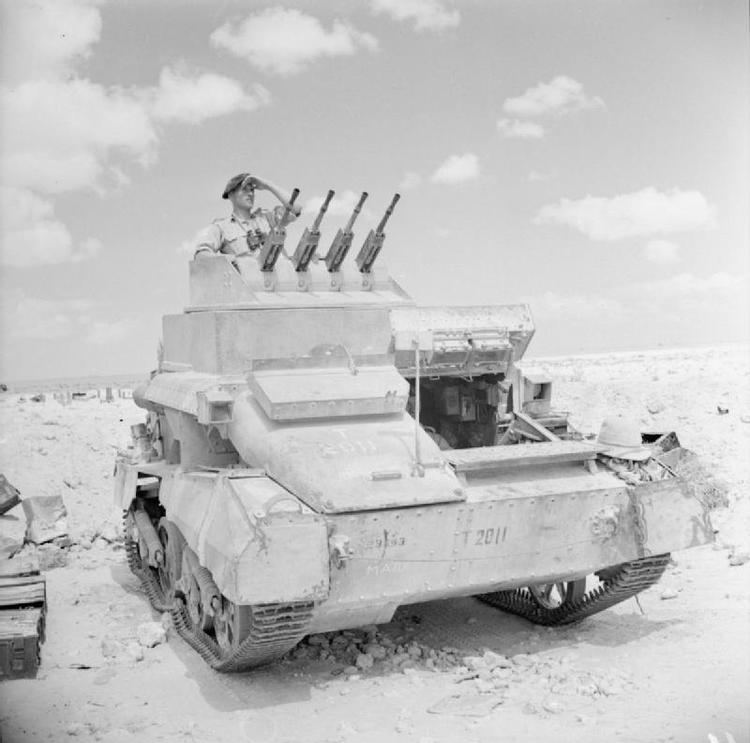Designer Václav Holek | Wars Second World War Designed 1936 | |
 | ||
Used by United Kingdom, Ireland | ||
The Besa machine gun was a British version of the Czechoslovak ZB-53 air-cooled, belt-fed machine gun, which in the Czechoslovak army was marked as the TK vz. 37. It was used extensively by the armed forces of United Kingdom during the Second World War, as a mounted machine gun for tanks and other armoured vehicles, to replace the heavier, water-cooled Vickers machine gun. Although it required a rather large opening in the tank's armour, it was dependable and reliable. The name came from the Birmingham Small Arms Company (BSA), who signed an agreement with Československá zbrojovka to manufacture the gun in the UK. The War Office ordered the weapon in 1938, and production began in 1939, after modifications.
Contents
Development and use
Although Britain's armed forces used the .303 in rimmed round for rifles and machine guns, the ZB-53 had been designed for the German 7.92×57mm Mauser round – referred to by the British as the 7.92mm. Although it had been intended for the British to move from rimmed to rimless ammunition generally, with war imminent wholesale change was not possible. It was considered by BSA and the Ministry of Supply that the industrial, technical, and logistical difficulty of converting the design to the .303 round would be more onerous than retaining the original calibre, especially given that the chain of supply for the Royal Armoured Corps was already separate from the other fighting arms of the British Army. As a consequence, the round was not changed for British production. Since the Besa used the same ammunition as Germany used in its rifles and machine guns, the British could use stocks of captured enemy ammunition.
While American-produced armoured cars or tanks would have been fitted with .30 cal Browning machine guns, many British tanks and armoured cars would be equipped with the Besa machine gun. It fed from non-disintegrating disposable 225-round steel metal-link belts.
The Mark II version entered service in June 1940. It was modified with a selector to give a high rate of fire (750–850 rounds per minute) for close combat or focused targets or a low rate of fire (450–550 rounds per minute) for long-range combat or area targets. As the war progressed the design was modified to be more rapidly and economically produced. Three simplified models, the Mark II*, Mark III and Mark III*, entered service in August 1943. The Mark II* was a transitional model designed to use the new simplified parts, but had backwards compatibility with the Mark II. The Mark III and Mark III* versions did away with the rate selector and had simplified parts like the Mark II*, but were not backwards compatible with the Mark II. The Mark III had a fixed high rate of fire (750–850 rpm) and the Mark III* had a fixed low rate of fire (450–550 rpm)
The earlier wartime Mark I, Mark II, and Mark II* versions of the Besa 7.92 mm were declared obsolete in 1951 and all Mark III versions were converted to Mark III*. The Mark III/2 introduced in 1952 was a conversion of the Mark III* with a new bracket and body cover. The later Mark III/3 introduced in 1954 was a conversion of the Mark III/2 that replaced the barrel and sleeve and made the gas vents larger on the gas cylinder to make it easier to use belts of mixed ammunition. The post-war Mark III/2 and Mark III/3 remained in service until the late 1960s.
15mm Besa machine gun
A larger, heavier – at 57 kg (125 lb) – 15 mm version, also belt-fed, was developed by BSA from the Czechoslovak ZB vz.60 heavy machine gun as vehicle armament. It could be fired in semi-automatic mode as well as fully automatic. It was introduced in British service in June 1940 and was used on the Light Tank Mk VIC and on armoured cars such as the Humber Armoured Car Marks I–III. Over 3,200 15mm Besa were manufactured until it was declared obsolete in 1949. It fired a 75 gram bullet from a 15×104mm cartridge with a muzzle velocity of 818.3 m/s (2,685 ft/s) at a rate of 450 rounds per minute. A few of the original ZB-60 guns were also used by the SS although mostly with the ammunition of the MG 151/15, which was slightly shorter having a case length of only 101 mm. The 15 mm Besa was fed from 25-round metal belts, which limited its practical rate of fire, although the weapon was usually used for single shots as it was difficult to fire accurately in automatic.
